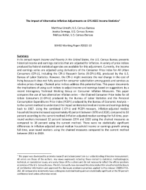Impact of Inflation Adjustments on CPS ASEC Income Statistics
The Impact of Alternative Inflation Adjustments on CPS ASEC Income Statistics
In its annual report Income and Poverty in the United States, the U.S. Census Bureau presents historical income and earnings statistics that are adjusted for inflation. A variety of price indices produced by federal statistical agencies are available for this adjustment. Currently, the income and earnings series are adjusted using derivations of the Consumer Price Index for All Urban Consumers (CPI-U), including the CPI-U Research Series (R-CPI-U-RS), produced by the U.S. Bureau of Labor Statistics. However, the CPI-U might overstate the real change in the cost of living because it does not fully account for consumer substitution among goods and services as relative prices change. Chained price indices address this potential bias. This paper documents the implications of using such indices to adjust income and earnings based on suggestions by a recent Interagency Technical Working Group on Consumer Inflation Measures. This paper compares the use of two alternative inflation series -- the Chained Consumer Price Index for all Urban Consumers (C-CPI-U) produced by the Bureau of Labor Statistics and the Personal Consumption Expenditures Price Index (PCEPI) produced by the Bureau of Economic Analysis -- to the current method to understand the impact on historical median income and earnings dating back to 1967. Using the combined C-CPI-U and PCEPI measure, inflation-adjusted median household income increased approximately 45 percent between 1970 and 2020, compared to 30 percent according to the current method. Inflation-adjusted median earnings for full-time, year-round workers increased 32 percent between 1974 and 2020 using the chained measures as compared to 18 percent using the current method. There were no statistically significant differences in inflation-adjusted annual median household income or earnings growth among full-time, year-round workers using the chained measures compared to the current method between 2015 to 2020.




